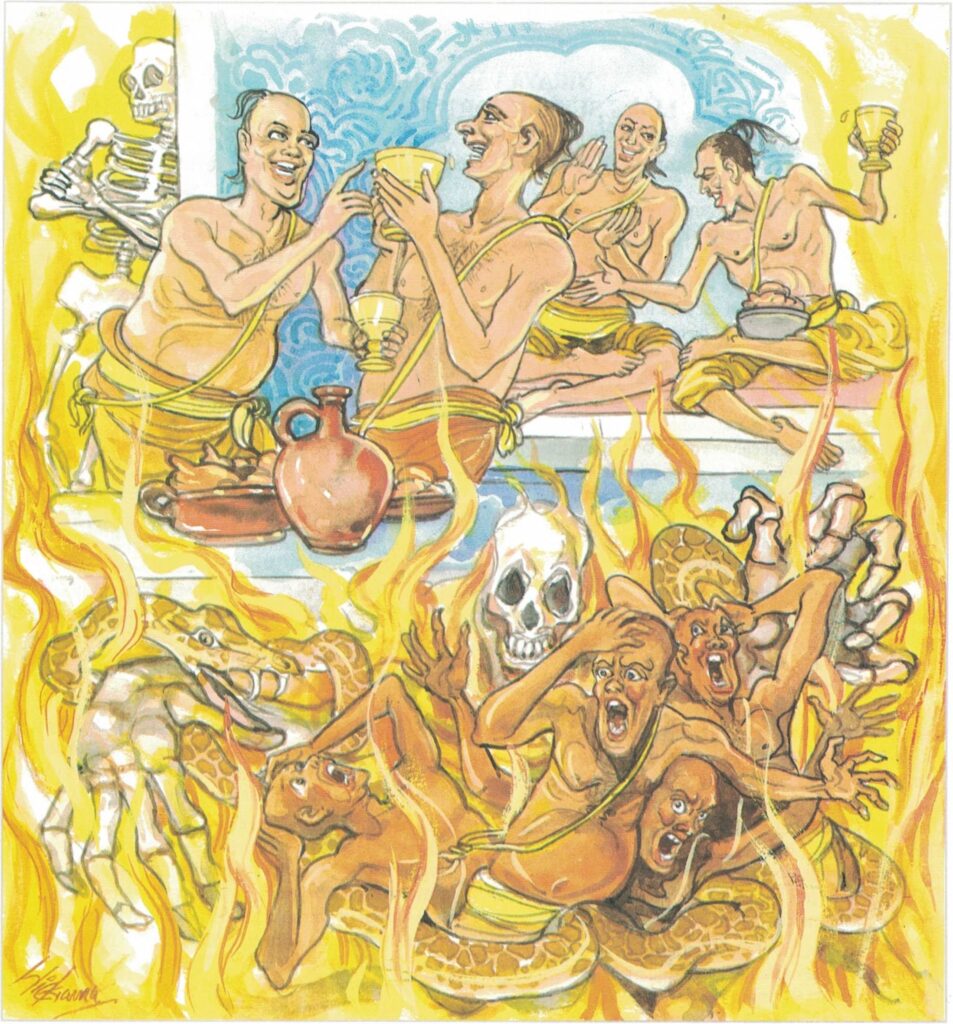Pali text, illustration and English translation of Dhammapada verse 307:
kāsāvakaṇṭhā bahavo pāpadhammā asaññatā |
pāpā pāpehi kammehi nirayaṃ te upapajjare || 307 ||
307. Many who wear the yellow robe are unrestrained in evil things, these evil ones by evil deeds in hell do they arise.

The Story of Those Who Suffered for Their Evil Deeds
While residing at the Veluvana Monastery, the Buddha spoke this verse with reference to some petas (ghosts).
Once, the Venerable Mahā Moggallāna was coming down the Gijjhakūṭa hill with Venerable Lakkhana when he saw some ghosts. When they were back at the Monastery, Venerable Mahā Moggallāna told Venerable Lakkhana, in the presence of the Buddha, that he had seen a ghost who was just a skeleton. Then he added that he had also seen five monks with their bodies burning in flames. On hearing the statement about those monks, the Buddha said, “During the time of Kassapa Buddha, those monks had done much evil. For those evil deeds they had suffered in hell and now they are serving out the remaining term of suffering as ghosts.”
Explanatory Translation (Verse 307)
kāsāvakaṇṭhā pāpadhammā asaññatā bahavo
te pāpā pāpehi kammehi nirayaṃ upapajjare
kāsāvakaṇṭhā: with a saffron robe round their necks; pāpā dhammā: sinful men; asaññatā: unrestrained people; bahavo [bahava]: are many; te pāpā: these sinners; pāpehi kammehi: due to their sinful acts; nirayaṃ [niraya]: in hell; upapajjare: are born
Many men wearing the yellow robe up to their necks who have an evil disposition and are unrestrained in thought, word and deed are reborn in hell on account of their evil deeds.
Commentary and exegetical material (Verse 307)
In this story, Venerable Mahā Moggallāna is referred to as having a companion by the name of Venerable Lakkhana. This friend and companion of Ven. Mahā Moggallāna cultivated merit during the dispensation of Padumuttara Buddha. Since that time he had heaped up much merit and finally he was born a brāhmin by the name of Lakkhana. His circle was Uruwela Kāsyapa and his two brothers Gayā and Nadī. With their conversion, he, too, later became an arahat. He was a friend and companion to Mahā Moggallāna. In the course of their travels, they came across a non-human spirit on the top of Vulture’s Peak (Gijjakūta) who was in one of the four states of woe, viz., pretha (ghost realm).
The others are hell, animal and demon states. He had the shape of a crow and was emitting flames. On being questioned about the reason for his suffering he said that once upon a time he was born as a bird in the family of the robin. During the dispensation of Kassapa Buddha, while people were offering alms to monks, this bird suddenly flew in that direction and snatched three mouthfuls of rice and flew away. It was the result of that action.
On another occasion, on the same spot, while the same pair was going, Mahā Moggallāna only saw a serpent with its immense length enveloped in flames, with a human face and a mouth like that of a pig. Venerable Mahā Moggallāna smiled but put off giving the reason of the smile till they met the Buddha. Venerable Lakkhana waited for the opportunity and then asked. The Venerable Moggallāna explained that while sympathising with suffering of that being, yet it was with a sigh of relief that he smiled, because for him such states of suffering were no longer possible. The Buddha concurred, and said that He, too, after Enlightenment at Gayā, saw the same serpent but did not wish to say anything as there would be skeptics. What a Buddha discloses, it would be a lapse for anyone not to believe. Besides, a Buddha’s utterance is well-timed. This applies to scientific developments about which the Buddha was silent. It does not, therefore, necessarily follow that the Buddha did not know them. Besides, they form no part of His mission. Here is testimony corroborated by the Buddha Himself. Lakkhana was one of the eight great arahats of the Sangha.